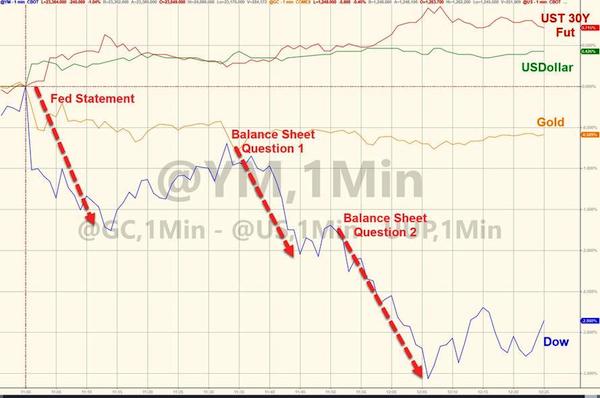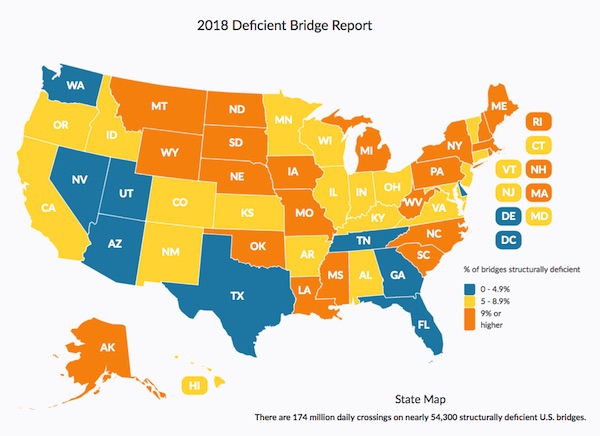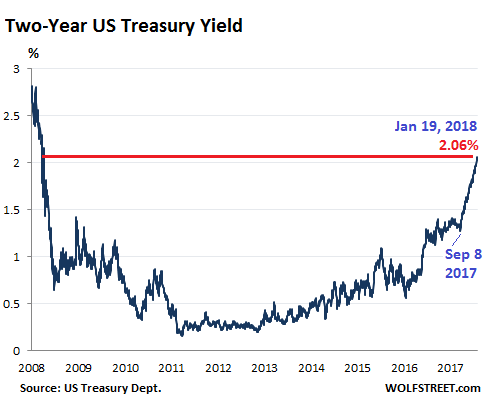
Hieronymous Bosch The Haywain Triptych c.1516 (click to enlarge)

And there’s still people who claim the stock market reflects the economy.
• The Stock Market Just Got Off To Its Best Start In 13 Years (MW)
Things are coming up roses in the stock market, lately. The Dow Jones Industrial Average, S&P 500 index and Nasdaq Composite Index are off to their best starts to a year since 2006 after a powerful series of gains. The Dow closed up 0.5% on Thursday, pushing its year-to-date gain to 2.89%, which would mark the best first seven days to a year since 2006, when stocks burst 3.04% higher over the same period. The S&P 500 rose 0.5% on the day and has returned 3.58% thus far this year, its best start since a 3.68% gain 13 years ago, while the Nasdaq Composite booked a 0.4% gain, enough for a 5.3% year-to-date advance, representing its best seven-session to kick off a year since its 5.72% rise also in 2006.
A late-session rally helped to solidify Thursday’s gains, coming after investors digested comments from Federal Reserve Chairman Jerome Powell, who pronounced at the Economic Club in Washington on Thursday afternoon that the economy is in good health, while adding that the central bank would be cognizant of stresses to financial markets amid rate hikes. The comments were a reiteration of Powell’s remarks last week during a broad panel discussion of current and former Fed bosses that helped to placate anxious investors and reverse what was shaping up to be another dismal year.


Why is everybody quoting a 2017 report?
• 78% of US Workers Live Paycheck To Paycheck (CNBC)
The partial government shutdown, which began Dec. 22, has now stretched well into the new year. President Donald Trump said Friday that it would continue for “months or even years” until he receives the requested $5 billion in funding for a border wall. The shutdown has left approximately 800,000 federal workers in financial limbo. Around 420,000 “essential” employees are working without pay, while another 380,000 have been ordered to stay home, according to calculations provided to CNBC by Paul Light, a professor of public service at New York University. In some cases, the furloughs have forced government employees to tap into their savings, rely on credit cards or crowdsource funds to make ends meet.
Government workers are far from alone in feeling stressed about not getting paid. Nearly 80% of American workers (78%) say they’re living paycheck to paycheck, according to a 2017 report by employment website CareerBuilder. Women are particularly vulnerable: 81% of them report living paycheck to paycheck, compared with 75% of men. Tony Reardon, president of the National Treasury Employees Union, tells CNBC that the group has heard from hundreds of frantic federal employees. “They’re scared,” he says. “They don’t know how they’re going to put food on the table.” Various #ShutdownStories making that point have gone viral on Twitter.
It’s not merely those earning low wages who are struggling. CareerBuilder reports that nearly 10% of Americans with salaries of $100,000 or more live paycheck to paycheck as well. That means that many workers aren’t able to put anything significant into savings. More than 50% of respondents say that they save less than $100 per month. And a comparable 2017 survey from GOBankingRates found that 61% of Americans don’t have enough money in an emergency fund to cover six months’ worth of expenses. [..] more than 70% of all respondents say that they’re in debt, and a quarter of workers say they weren’t able to make ends meet at the end of every month of the past year.

Which his own Fed has encouraged like nobody else could.
• Fed’s Powell Says He Is ‘Very Worried’ About Growing Amount Of US Debt (CNBC)
Federal Reserve Chairman Jerome Powell is concerned about the ballooning amount of United States debt. “I’m very worried about it,” Powell said at The Economic Club of Washington, D.C. “From the Fed’s standpoint, we’re really looking at a business cycle length: that’s our frame of reference. The long-run fiscal, nonsustainability of the U.S. federal government isn’t really something that plays into the medium term that is relevant for our policy decisions.” However, “it’s a long-run issue that we definitely need to face, and ultimately, will have no choice but to face,” he added. The Fed chief’s comments came as the annual U.S. deficit reaches new sustained highs above $1 trillion, a fact many economists worry could spell trouble for future generations.
Annual deficits have topped $1 trillion before, but never during a time of sustained economic growth like now, raising concern about what would happen if a recession hits. Total U.S. debt is about $21.9 trillion, of which $16 trillion is owed by the public. In part because of continued rate increases under Powell, the interest cost on that debt could start to become a bigger and bigger burden. Wall Street’s “bond king” and respected financial prognosticator Jeffrey Gundlach said in December that the Fed seems to be on a “suicide mission,” raising rates while the government deficit increases as a share of GDP. Normally when the deficit is expanding, the Fed would be lowering interest rates.

View from the MSM: Trump digs in, not the Dems.
• Trump Digs In As Shutdown Continues (BBC)
US President Donald Trump has threatened again to declare a national emergency to fund a border wall without Congress’s approval. “I have the absolute right to declare a national emergency,” he told reporters. The White House has denied reports it is looking at diverting funds set aside for reconstruction projects. A political row over funding the wall has left the US government partially shutdown for 20 days, leaving about 800,000 federal employees without pay. President Trump has refused to sign legislation to fund and reopen the government if it does not include $5.7bn for a physical barrier along the US-Mexico border.
But budget talks have come to a standstill as Democrats – who control the House of Representatives – refuse to give him the money. Republican leaders insist the party stands behind the president, although some Republican lawmakers have spoken out in favour of ending the shutdown. On Thursday, Mr Trump visited a border patrol station in McAllen, in the Rio Grande Valley of Texas. He said that if Congress did not approve funding for the wall, he would “probably… I would almost say definitely” declare a national emergency to bypass lawmakers. But such a move is likely to face legal challenges. The money would also have to come from funds allocated by Congress for other purposes – which some Republicans would also oppose.

Planning a huge media spectacle. Imagine all the readers and viewers… Trump keeps on giving. Bread and circuses it is.
• Michael Cohen To Testify Publicly Before Congress In February (G.)
Donald Trump’s longtime lawyer and aide Michael Cohen says he has accepted an invitation from a top House Democrat to testify publicly before Congress next month. His testimony before the House oversight and reform committee on 7 February will be the first major public oversight hearing for Democrats, who have promised greater scrutiny of Trump after winning control of the House in the 2018 midterm elections. Cohen said in a statement: “I look forward to having the privilege of being afforded a platform with which to give a full and credible account of the events which have transpired.”
The New Yorker, who is to begin a three-year prison sentence in March, is a pivotal figure in investigations by the special counsel Robert Mueller into potential collusion between Russia and the Trump campaign, and by federal prosecutors in New York into campaign finance violations related to hush-money payments to two women who say they had sex with Trump. Elijah Cummings, the committee’s chair, said the panel would avoid interfering with Mueller’s investigation. “We have no interest in inappropriately interfering with any ongoing criminal investigations, and to that end, we are in the process of consulting with Special Counsel Mueller’s office,” Cummings said in a statement.

But not to the 1.67% predicted by professor Xiang Songzuo, I’m sure.
• China Set To Lower GDP Growth Target In 2019 (R.)
China plans to set a lower economic growth target of 6% to 6.5% in 2019 compared with last year’s target of “around” 6.5%, policy sources told Reuters, as Beijing gears up to cope with higher U.S. tariffs and weakening domestic demand. The proposed target, to be unveiled at the annual parliamentary session in March, was endorsed by top leaders at the annual closed-door Central Economic Work Conference in mid-December, according to four sources with knowledge of the meeting’s outcome. Data later this month is expected to show the Chinese economy grew around 6.6% in 2018 — the weakest since 1990. Analysts are forecasting a further loss of momentum this year before policy support steps begin to kick in.
“It’s very difficult for growth to exceed 6.5% (this year), and there could be trouble if growth dips below 6%,” said one source who requested anonymity due to the sensitivity of the matter. As the world’s second-largest economy loses steam, China’s top leaders are closely watching employment levels as factories could be forced to shed workers amid a trade war with the United States, despite a more resilient services sector, policy insiders said. Growth of about 6.2% is needed in the next two years to meet the ruling Communist Party’s longstanding goal of doubling gross domestic product and incomes in the decade to 2020, and to turn China into a “modestly prosperous” nation. [..] Local governments could be allowed to issue up to 2 trillion yuan worth of special bonds in 2019, up from 1.35 trillion yuan last year, they said.

Goldman Sachs to the -image- rescue.
• Can The Chinese Consumer Be Resurrected? (Jim O’Neill)
Last week, Apple published a letter to shareholders revising down its expected revenues for the first quarter of 2019, citing an economic slowdown in China, which has become an increasingly important market for iPhone, Mac, and iPad sales. Though tech industry analysts are debating whether internal dynamics at Apple might also explain the change, the company’s new guidance nonetheless adds to the evidence that Chinese consumption is slowing. A sustained decline in Chinese consumption would be even more worrying than the current US-China trade dispute.
Given that US trade policies and other external influences should not have much effect on domestic Chinese spending, the problem may be more deeply rooted in China’s economic model. To understand what is at stake, consider all that has changed just within the past decade. At the end of 2010, domestic consumption accounted for around 35.6% of Chinese GDP, according to official Chinese data. That was remarkably low compared to most other economies, not least the US, where consumption accounted for almost 70% of GDP. In nominal dollar terms, China’s domestic consumption thus was around $2.2tn, or almost five times lower than that of the US ($10.5tn).
Yet China’s high overall growth rate meant that Chinese consumers could potentially play a much larger role, with far-reaching benefits for global brands such as Apple, BMW, Burberry, Ford, and many others. As of 2017, Chinese consumption as a share of GDP had risen to 39.1%, representing just over $5tn in nominal dollar terms. That is an increase of almost $3tn in just seven years. And though Chinese consumer spending still lagged far behind that of the US ($13.5tn in 2017), the gap has narrowed. If China were to continue on the same trajectory in terms of nominal GDP growth and domestic consumption, its consumer spending could increase by another $2tn by 2020, putting it at around half that of the US. Chinese consumers would be more relevant to the global economy than anyone except Americans.

From time to time you wonder what’s more hysterical, the Brexit mayhem or the UK’s fabricated Russophobia. This is pretty unbelievable, but it’s become normal.
Layla Moran is a Liberal Democrat MP for Oxford West and Abingdon.
• Why I Asked May If She Is On The Side Of Putin Or The People (Moran)
For all the farcical invoking of Blitz spirit, Brexit isn’t merely an absurdist experiment in English nationalist nostalgia – it is the most audacious example yet of a futuristic Russian nationalism that seeks to divide and rule Europe. If we can be judged by our friends then Brexit has no stauncher ally than Vladimir Putin. After all, Donald Trump has proved unreliable. But Putin? It is hard to think of anyone who has done more for the cause (and that is not to take anything away from the years of Brexit monologues by Tory MP Bill Cash). Russian bot farms have been exposed as having supported the Leave campaign. This comes on top of allegations of iffy Russian money funding Brexit campaigns, and Arron Banks’ almost comical inability to explain his donations to Leave.
Comical, that is, if his scarcely thought through Brexit wasn’t driving Britain to what Hilary Clinton has called the single biggest act of deliberate self-harm a nation has ever committed. As if Russian interference in the original referendum was not shocking enough, it is still going on. The Channel 4 drama Brexit: The Uncivil War might have relegated Russian involvement to the briefest postscript, but in reality Putin is still in the trenches fighting for a hard Brexit. At a recent press conference Putin attacked the idea of a referendum on the deal, claiming the original result should be respected. Oh, the irony! Putin, the arch kleptocrat, giving advice on democracy. “Don’t steal Brexit,” he seemed to demand, while probably stealing (sorry, being gifted) another superyacht.
It should have been sufficiently chilling to make even Boris Johnson pause for thought. And all while using the Brexiteer message script of delivering the will of the people. As any student of Russian history could tell you, “the people” are often invoked by the Kremlin, including when justifying the mass murder of innocent people. But rarely does the Kremlin actually ask “the people” for anything so radical as an opinion. For Putin, “the people” are to be manipulated and even killed for his own ends. And Putin’s ends are clear. He wants a weak and divided EU. Ultimately, he seeks to break it up, with the Eastern bloc – brought into the European fold by Margaret Thatcher’s single market – dragged back into the lair of the Russian bear.

And why not? If all else fails, scare them.
• May’s Brexit Deal ‘Threat To National Security’ – Former MI6 Chief (Ind.)
The former head of MI6 has warned Theresa May’s Brexit deal will “threaten the national security of the country”, in a call for Tory MPs to reject it. The agreement would “place control of aspects of our national security in foreign hands”, claims Sir Richard Dearlove, in an extraordinary letter to Conservative associations. It has also been signed by Lord Guthrie, a former chief of the defence staff, in a bid to stiffen grassroots resistance, ahead of next Tuesday’s vote.= Sir Richard and Lord Guthrie, who are both prominent Leave supporters, write: “Please ensure that your MP votes against this bad agreement.” The prime minister, a former home secretary, has insisted her agreement would protect national security by retaining existing cooperation arrangements during the 21-month transition.
However, she was forced to acknowledge the UK was likely to lose direct access to vital EU security databases after 2012, under the proposed long-term arrangements. In their letter, the ex-security chiefs argue the deal is dangerous because it would weaken membership of Nato and existing “close” defence and intelligence ties with the US. “This withdrawal agreement, if not defeated, will threaten the national security of the country in fundamental ways,” it says. Downing Street hit back immediately, insisting the letter was “completely wrong” and that the Brexit deal offered the broadest security agreement the EU has with any of its partners. But both sides of the Brexit divide seized on the intervention, arch-Brexiteer Owen Paterson calling it a “devastating warning”.

After Tuesday all bets are off.
• May Begs Unions To Help Salvage Her Brexit Deal (Ind.)
Theresa May has called the leaders of Britain’s biggest unions for the first time since becoming prime minister in a desperate bid to find backing for her Brexit deal. The calls to Unite leader Len McCluskey and the GMB’s Tim Roache – whose unions are Jeremy Corbyn’s biggest financial backers – mark just how far she is being forced to go in the hope of finding support for the deal expected to be rejected by MPs next week. She was scorned by second referendum-backing Mr Roache, who joked after his call that he was “glad the prime minister finally picked up the phone”. The unprecedented move came as she also sought to convince Labour MPs to back her by promising new commitments to maintain workers’ rights in line with EU standards after Brexit.
But expectations that she is heading for a heavy defeat on Tuesday simply grew further, with some estimates suggesting that opposition has actually grown since she delayed the vote on her deal in December. Capitalising on the deep Tory divisions, Mr Corbyn instead invited Conservative MPs to back a motion of no confidence in the government which he is promising to table if Ms May’s plans are defeated. Downing Street confirmed the calls to Mr Roache, whose union has 620,000 members, and Mr McCluskey, representing more than 1.4 million, and admitted it was the first time she had spoken to either of them since her arrival at No 10. The Independent understands the prime minister also attempted to call Dave Prentis, leader of Unison which also has some 1.4 million members, but could not get through because Mr Prentis was travelling.

Click here for the original Hill article.
• US Defenses No Match For Russian Hypersonic Missiles – Retired US General (RT)
A retired general and chief of staff has warned that the US’ missile defense systems are “simply incapable” of stopping the latest generation of Russian hypersonic missiles – some of which fly at 27 times the speed of sound. Now retired, Maj. Gen. Howard ‘Dallas’ Thompson was once Chief of Staff at US Northern Command in Ohio. In a column published by The Hill on Thursday, Thompson argues that military leaders have neglected to develop proper defenses against the hypersonic threat. There have been some calls for the US to pursue hypersonic weapons in defense policy circles, but America has lagged behind China – which conducted more tests in the last year than the US has is a decade – and Russia, which successfully tested such a missile in December. The ‘Avangard’ missile flew at Mach 27, and will be deployed in 2019.
At present, the US Missile Defense Agency’s sensors and radars are designed for one purpose: to counter an intercontinental ballistic missile (ICBM) fired by an adversary like Iran or North Korea. ICBMs have a predictable flight path, and the US’ Patriot and Terminal High-Altitude Area Defense (THAAD) batteries stand a reasonable chance of intercepting and destroying any incoming missiles. Not so with hypersonics. Missiles like ‘Avangard’ fly low and fast, evading radar detection. They can also engage in evasive maneuvers to dodge surface-to-air rockets or missiles, further lowering the chances of a successful interception.
“The stark reality is that our current missile defense systems, as well as our operational mindset, are simply incapable versus this threat,” Thompson wrote. The retired General’s words are backed up by a recent report from the Government Accountability Office, which concluded that there are “no existing countermeasures” against the threat. Thompson claims that a massive collaborative program between the Department of Defense and arms companies is needed to counter Russian and Chinese advances. “Countering this threat will require U.S. investment in an extensive defensive architecture,” he wrote. “…a highly robust ‘family of systems’ that nonetheless must be envisioned, designed, developed and deployed in a completely holistic manner.”

800 bases, of which 300 are unreported?!
• Bases, Bases, Everywhere… Except in the Pentagon’s Report (Turse)
Within hours of President Trump’s announcement of a withdrawal of U.S. forces from Syria, equipment at that base was already being inventoried for removal. And just like that, arguably the most important American garrison in Syria was (maybe) being struck from the Pentagon’s books — except, as it happens, al-Tanf was never actually on the Pentagon’s books. Opened in 2015 and, until recently, home to hundreds of U.S. troops, it was one of the many military bases that exist somewhere between light and shadow, an acknowledged foreign outpost that somehow never actually made it onto the Pentagon’s official inventory of bases. Officially, the Department of Defense (DoD) maintains 4,775 “sites,” spread across all 50 states, eight U.S. territories, and 45 foreign countries.
A total of 514 of these outposts are located overseas, according to the Pentagon’s worldwide property portfolio. Just to start down a long list, these include bases on the Indian Ocean island of Diego Garcia, in Djibouti on the Horn of Africa, as well as in Peru and Portugal, the United Arab Emirates, and the United Kingdom. But the most recent version of that portfolio, issued in early 2018 and known as the Base Structure Report (BSR), doesn’t include any mention of al-Tanf. Or, for that matter, any other base in Syria. Or Iraq. Or Afghanistan. Or Niger. Or Tunisia. Or Cameroon. Or Somalia. Or any number of locales where such military outposts are known to exist and even, unlike in Syria, to be expanding.
[..] According to David Vine, author of Base Nation: How U.S. Military Bases Abroad Harm America and the World, there could be hundreds of similar off-the-books bases around the world. “The missing sites are a reflection of the lack of transparency involved in the system of what I still estimate to be around 800 U.S. bases outside the 50 states and Washington, D.C., that have been encircling the globe since World War II,” says Vine

The reporting on the issue seems broken.
• Oceans Warming Faster Than Expected, Set Heat Record In 2018 (R.)
The oceans are warming faster than previously estimated, setting a new temperature record in 2018 in a trend that is damaging marine life, scientists said on Thursday. New measurements, aided by an international network of 3,900 floats deployed in the oceans since 2000, showed more warming since 1971 than calculated by the latest U.N. assessment of climate change in 2013, they said. And “observational records of ocean heat content show that ocean warming is accelerating,” the authors in China and the United States wrote in the journal Science of ocean waters down to 2,000 metres (6,600 ft). Man-made greenhouse gas emissions are warming the atmosphere, according to the overwhelming majority of climate scientists, and a large part of the heat gets absorbed by the oceans.
That in turn is forcing fish to flee to cooler waters. “Global warming is here, and has major consequences already. There is no doubt, none!” the authors wrote in a statement. Almost 200 nations plan to phase out fossil fuels this century under the 2015 Paris climate agreement to limit warming. [..] Data due for publication next week will show “2018 was the warmest year on record for the global ocean, surpassing 2017,” said lead author Lijing Cheng, of the Institute of Atmospheric Physics at the Chinese Academy of Sciences. He told Reuters that records for ocean warming had been broken almost yearly since 2000. Overall, temperatures in the ocean down to 2,000 metres rose about 0.1 degree Celsius (0.18F) from 1971-2010, he said.

Another issue on which reporting seems broken. We’re not getting anywhere.
• Julian Assange’s Living Conditions Deteriorate (Cassandra Fairbanks)
I last visited Assange in March, days before the Ecuadorians placed the award-winning journalist in isolation for allegedly violating a draconian ban on all public political comments. [..] In order to visit the publisher last year, I simply organized it with him and his lawyer and went. This time I was required to provide details about my social media, my employer, and my reason for visiting in advance of my arrival and hope to be approved. If I wanted to bring my cell phone, I would have had to provide the brand, model, serial number, IMEI number and telephone number. Providing these details to a foreign nation with extreme surveillance seemed unwise, so I left it behind.
[..] Currently, Assange cannot even have a simple visit with a friend without it being monitored by some shadowy state actor. It’s like a scene from the Stasi spy drama The Lives of Others. While Ecuador presents this surveillance operation as a mission to “protect and support” Assange, this is contradicted by the fact that he isn’t even allowed to confidentially speak with a reporter and friend without being recorded. In May, the Guardian reported that there are “extraordinary reports” from these spies that include daily logs of Assange’s activities inside the embassy, even noting his “general mood.”
As John Pilger pointed out after his visit with Assange on New Year’s Eve, it could be any newspaper publisher or editor stuck in that embassy. For the crime of publishing journalism, Assange has not only had to give up his freedom, but also any semblance of privacy. It’s impossible to overstate how unsettling it feels to have multiple lenses pointed at you wherever you stand. Unable to speak privately, even with a noise machine attempting to muffle the microphones from picking up conversations, we resorted to passing notes. Assange is not only barred from sharing his views online under the new regulations — thanks to the constant surveillance, he can’t even do so among his friends in the embassy where he is arbitrarily detained.
If we value the principle of the freedom of speech — we must do something to stop this madness. While we do not know what Assange has been charged with by the U.S. as it remains under seal, we do know that it is related to his work as a publisher, the only publisher with a record of 100% accuracy. His dedication to truth is so profound that he has never once had to issue a correction or retraction.
























































